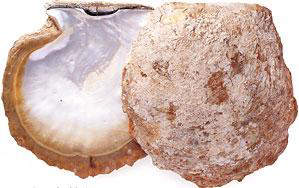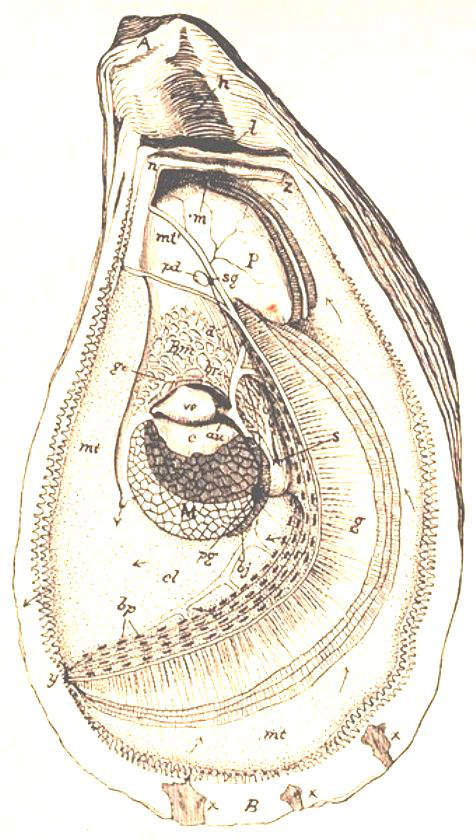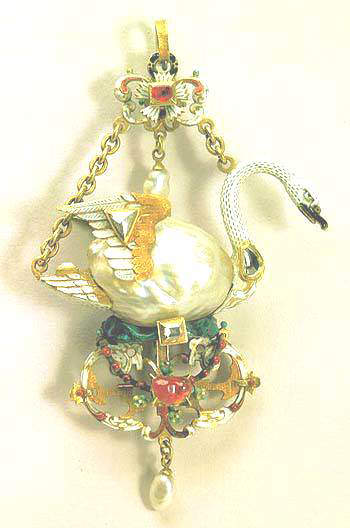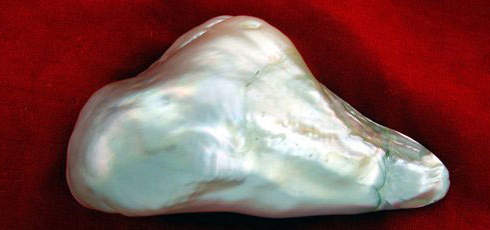An Unusual Pearl - A Large, Natural, Hollow, Baroque, Nacreous, Blister Pearl - The Star of Hope Pearl
Open FREE Unlimited Store Join Our Newsletter
A large baroque South Sea blister pearl comes into prominence in early 2009
An unusual pearl is submitted to the GIA Laboratories, Bangkok for testing and issue of reports
In March 2009, an unusually large nacreous baroque pearl was submitted to the GIA Laboratories in Bangkok, Thailand, for testing and issue of Pearl Identification and Classification Reports.
Gemologists at the laboratory were surprised when they first saw the pearl, not only because of its extraordinary size, but also because of the unusual appearance of the surface of the pearl at one end of its rear side, which looked different from the other areas of the pearl, and slightly yellowish in color. The pearl also appeared to be too heavy for its size, and gemologists at the GIA, who had experience in examining such large pearls before, knew that these large baroque pearls were blister pearls that originated in the saltwater pearl oyster species, Pinctada maxima (Silver-lipped pearl oyster), whose natural home is the South China Sea, and were invariably hollow. They also knew by experience that the hollow cavities of several such pearls submitted to the laboratory in the past, had been filled with various materials, and given the initial observation that the pearl was too heavy for its size, this pearl also appeared to be no exception.
Initial suspicion that the hollow cavity of the pearl had been filled with foreign materials is confirmed by Micro-radiographical studies
Microradiographical studies conducted by the GIA gemologists confirmed the initial suspicion, and showed that the hollow cavity of the pearl was occupied by two pieces of metal, and space between them filled with strips of a less opaque substance, possibly pieces of shell, that stabilized the metallic objects inside and prevented it from moving. Further tests revealed that the yellowish area behind the pearl that looked different from the other areas, was the region through which the metal objects and the strips were inserted into the hollow cavity of the pearl, by creating an opening in the nacreous material and subsequently plugging it with a material suspected to be Araldite. The coated and modified area as well as the entire surface of the pearl, had then been subjected to some form of polishing to improve the luster and appearance of the pearl.
GIA issues a Natural Pearl Identification Report for the controversial pearl, but not a Classification Report
Having concluded the tests, the GIA issued a "Natural Pearl Identification Report" for the pearl, but not a "Classification Report" as requested by the owner. A "Classification Report" in addition to the usual information provided in a standard "Pearl Identification Report" also provides information on the pearls luster, surface condition and matching, when applicable. Such reports are issued only for pearls that are not treated significantly. Minor to average polishing which most pearls are subjected to these days, are not considered to be significant.
Characteristics of the Pearl
Characteristics of the Pearl according to the GIA's Pearl Identification Report
The GIA's Natural Pearl Identification Report, in respect of this pearl is dated March 26, 2009 and bears No. 7102267946. The report is given under three headings :- General Description, Identification and Detailed Description.
The weight and the dimensions of the pearl
The weight and dimensions of the pearl are given under the General Description. Accordingly the massive pearl has dimensions of 58.21 x 32.70 x 20.97 mm and a weight of 74.49 grams, equivalent to 372.45 carats. There is no evidence of drilling on the pearl, pointing to its recent origins. The 575-carat Arco-Valley Pearl, one of the largest and oldest nacreous blister pearls in the world, dating back to the 12th or 13th century, show evidence of drilling at least three times, at three different points on the pearl, which has been subsequently plugged with a cement.

The Star of Hope Pearl- Unusual large natural, hollow,baroque, nacreous, blister pearl
© GIA
A natural hollow blister pearl formed inside the mollusk species Pinctada maxima
Under the heading, Identification, the report gives the type of pearl, the environment in which it was formed, the Mollusk species from which it was produced, and treatments if any carried out on the pearl. The pearl is described as a "natural hollow blister pearl" formed in a saltwater environment, from the Mollusk species, Pinctada maxima, commonly known as the silver-lipped pearl oyster. The 575-carat Arco-Valley Pearl, the world's largest nacreous blister pearl, is also believed to have originated from the silver-lipped pearl oyster, Pinctada maxima, from the South China Sea. Under treatments, the report says, that the hollow cavity in the middle of the pearl has been filled. The pearl is said to be partially coated, worked and polished. Scientists of GIA Bangkok believe, that in all probability this pearl would have formed as a hollow natural pearl, most likely attached to its host at the point where it was eventually worked and filled with the foreign fillers now within it and subsequently coated to hide evidence of this working and filling.
A white baroque pearl
Then under the heading, Detailed Description, only the shape of the pearl and the body color of the pearl are given. The shape is given as baroque and the body color as white. The remaining properties, overtone, luster, surface quality, nacre thickness, matching are indicated as Not Applicable (N/A), as such information is not provided for treated pearls.
Surface quality and luster modified by polishing
Under comments below the report, more details are given on the treatment of the pearl. The comments read as follows :- This pearl is filled with foreign materials and the surface and luster have been modified. The weight is significantly affected by the fillings. Finally, a photograph of the front and back view of the pearl is given at the end of the report, which also indicated the modified yellowish area on the pearl.
History of the Pearl
The species of pearl oyster that produced the pearl
The species of pearl oyster that produced this massive, baroque, nacreous, blister pearl is Pinctada maxima, the silver-lipped pearl oyster, a fact authenticated by the GIA. The discovery of such large blister pearls in the silver-lipped pearl oyster had been reported before, although their occurrence is extremely rare. A well-known example of a such a large blister pearl, that originated in Pinctada maxima, is the 575-carat Arco-valley Pearl, with a very ancient history and given as a gift by the Mongol Emperor Kublai Khan, grandson of the mighty conqueror Genghis Khan, to Marco Polo, the famous Venetian traveler and adventurer, in the 13th century, in appreciation of his services to the emperor as governor and diplomat. Pinctada maxima is one oyster species that can grow to an enormous size, and reach a maximum diameter of 30 cm (12 inches). The blister pearl that develops between the mantle and the shell, can grow to enormous sizes, given the large size of the oyster, that can accommodate such large pearls.
Arco-Valley Pearl
Definition of blister pearl according to CIBJO, the World Jewelry Confederation
According to the CIBJO, a blister pearl is a natural pearl, that has perforated the mantle of the mollusk and has naturally adhered, through layers of nacreous or non nacreous secretions applied by the mollusk, to the inner wall of the shell. The subsequently formed layers of nacreous or non nacreous material are continuous with those of the inner wall of the shell. They are round or irregular in shape and are secreted without human intervention (Scarratt, 2001). The base of natural blister pearls, the point of attachment of the pearl to the shell, may be worked, by significantly removing layers of nacreous or non-nacreous material to remove scars and blemishes and reshape the pearl, a process known as peeling.
Working, peeling and polishing of blister pearls are accepted procedures by CIBJO but not filling the hollow cavity with foreign materials
Thus, the working, peeling and polishing of the "Star of Hope" blister pearl, as described in the GIA report is an accepted procedure by the World Jewelry Confederation, for blister pearls. The same thing however cannot be said of the filling of the hollow cavity with foreign materials, that significantly affected the weight of the pearl.
The source of the pearl
The source of the "Star of Hope" blister pearl is the natural range of the pearl oyster, Pinctada maxima, which is the South Sea that connects the Indian and Pacific Oceans, and lies between the southern coast of China and the northern coast of Australia. Malaysia, the Indonesian archipelago, the Philippines and Papua New Guinea lie within this sea. Two varieties of Pinctada maxima, the silver-lipped pearl oyster and the golden-lipped pearl oyster live within this range, and cultured pearl industries based on these two varieties have developed in most of the countries of the region, such as Australia, Myanmar, Philippines, Indonesia, Malaysia, and Thailand.
Was Philippines the country of origin of the pearl?
The country of origin of the "Star of Hope" blister pearl is not known, but the pearl was named by its owner "Bituin Pag-asa" which in the Filipino Language means "Star Hope." The owner of the pearl named it so in honor of his mother, whose name was "Bituin" meaning "Star," and his aunt. whose name was "Pag-asa" meaning "Hope." Since the enormous blister pearl has been named in the Filipino Language, we can assume that the owner of the pearl is most probably a Filipino. Hence, it may not be too far fetched to assume that the pearl was also discovered in the waters off the coast of one of the islands of the Philippines, which also falls within the South Sea, the natural home of the silver-lipped pearl oyster.
Classification of Pinctada Maxima
Kingdom : Animalia
Phylum : Mollusca
Class : Bivalvia
Order : Pterioida
Family : Pteriidae
Genus : Pinctada
Species : maxima
Common name : Silver-lipped pearl oyster
: Golden-lipped pearl oyster
: White-lipped pearl oyster

Pinctada maxima
© PEARL AQUACULTURE RESEARCH FOUNDATION
The Anatomy of Pinctada maxima
Pinctada maxima, a bivalve mollusk that belongs to the family Pteriidae, is the largest naturally occurring pearl oyster in the world, growing to a maximum size of 30 cm in diameter. It is also the largest commercially harvested cultured pearl oyster in the world, that produces the largest cultured pearls in the world, ranging in size from 9-20 mm, and an average size of around 12-13 mm.

Bivalve Anatomy (Cross section)
Pinctada maxima being a bivalve, has a soft body, enclosed and protected by a shell made up of two calcareous valves, hinged dorsally by interlocking teeth and elastic ligament and open ventrally. The oyster usually lies on one side, and the upper valve is usually larger than the lower valve. Two adductor muscles, an anterior and posterior adductor muscle, are attached to the inner surfaces of the two valves and act antagonistically to the hinge ligament, causing the shell to close rapidly and tightly. Relaxation of the adductor muscles allows the ligament to open the valves. Lining each valve is the mantle tissue that secretes the layers of the shell, the organic outer layer called the periostracum and the inner nacreous layer known as the mother-of-pearl layer. Between the two shell mantle layers is the pallial cavity that contains the visceral mass, consisting of the organs of digestive, respiratory, excretory, circulatory and reproductive systems.
The posterior mantle edge of many bivalves are fused into incurrent and excurrent siphons. The incurrent siphon brings oxygenated water and food particles into the mantle cavity, and the excurrent siphon removes waste products and reproductive products such as sperms and ova, out of the mantle cavity. The head is very much reduced without without eyes or tentacles. Radular teeth typical of most mollusks are absent, but the stomach is complex, with ciliated sorting areas and ridges, as well as the crystalline style, an enzymatic rod, that rotates against a hardened gastric shield lining the dorsal stomach surface, to facilitate extra-cellular digestion. The nervous system is simple and reduced, consisting of only three pairs of ganglia connected by nerve fibers. The circulatory system is open, consisting of a three-chambered heart, arteries, veins and blood sinuses. Expansion and retraction of structures such as the foot, tentacles and siphon, are caused by the haemostatic pressure of the fluid in blood cavities.
Feeding and Respiration in Pinctada maxima
The gills, suspended within the mantle cavity are usually very large, and perform a dual function, of taking part in respiration as well as filter-feeding. Like all bivalve mollusks, Pinctada maxima oysters are also filter feeders. While water entering through the incurrent siphon passes over the gills, respiratory exchange of gases take place, and suspended plankton and other tiny organic particles are strained out, and directed by the beating of cilia towards the mouth, where they are ingested. The ingested food particles are digested and absorbed, and undigested material expelled as faeces.

Bivalve Anatomy
© Virginia Tech- Freshwater Ecology
Apart from the gills that are used for the respiratory exchange of gases, oysters can also exchange gases across their mantle, which is lined with a network of thin-walled blood vessels. A small three-chambered heart, lying under the adductor muscle, pumps colorless blood to all parts of the body. Two kidneys also located on the underside of the muscle, remove waste products from the blood.
Growth and Reproduction in Pinctada maxima
Growth rates of young oysters are very fast. The veliger larvae that metamorphose into juveniles reach an average size of 56 mm (5.6 cm) within just 6 months, and 100 mm (10 cm) within 18 months (1½ years) and 120 mm (12 cm), within 24 months (2 years). Growth slows down after this and oysters that are 200 mm (20 cm) or more in size, are 15 to 20 years old. In other words for the size to increase from 120 mm to 200 mm it takes an average of 13-18 years. Adult oysters can reach a maximum size of 270-300 mm (27-30 cm).
Pinctada maxima is a protandrous hermaphrodite - i.e. when the animal becomes sexually mature, it first behaves as a male and when it grows older it becomes a female. When the animal is around 3 to 4 years of age and has a size of 110 to 120 mm, they become sexually mature as males. The gonads produce millions of sperms at the time of spawning. When the animals grow further in age and size, the sex changes to females, and when the size of the animals are around 170 mm, half the animals are males and other half females. When the size of the animals reach around 190 mm, the entire population becomes female. Animals spawn every year, and thus each individual oyster, can function both as male and then female for several spawning seasons.
The breeding season of Pinctada maxima, in the waters off the coast of northern and western Australia, begin in the spring months of September or October and continue until the autumn months of April and May. The peak of the spawning season occurs from the middle of October to December, and a second peak takes place in February and March. Males and females spawn millions of sperms and eggs into the surrounding water, where fertilization takes place. Female oysters can spawn between 2 to 12 million ova during a spawning season. Fertilized ova develop into veliger larvae. Veligers are planktons, that float about in the water, and can colonize new areas if suitable substrate can be found. Veliger larvae settle between days 28 to 35. When an appropriate substrate has been found the veligers settle and metamorphose into juveniles. Veligers that fail to find a suitable substrate metamorphose and die. Less than 1% of fertilized eggs become veligers that successfully settle on a suitable substrate. The juveniles attach themselves to the hard substrate by byssal threads and develop into adults. Pinctada maxima occurs at depths ranging from the inter-tidal zone to 80 meters, living on shallow rocky pavements on the continental shelf, where there are small crevices, into which the young animals can settle and develop.
During the Renaissance period large baroque pearls were incorporated into sculptural pendants
Large, natural, nacreous, baroque, blister pearls of this size and magnitude are extremely rare and have an enormous collectors value. The sheer size of such pearls precludes them from being used in any form of jewelry, except in renaissance style pendants as in the past, such as the Canning Jewel in the Victoria-Albert Museum, London; the Swan pendant, Caravel pendant, Mars pendant, Siren pendant, and Cupid pendant, all in the State Hermitage Museum, St. Petersburg, Russia. Most of these "sculptural pendants" incorporate a large baroque-shaped, nacreous pearl, to give the shape and design that had borne-fruit in the fertile imagination of the designer, and were created in the late 16th or early 17th centuries. Such unique and exquisite creations preserved in several museums around the world, have an inestimable value, and serve as a living testimony to the ingenuity and creativity of the renaissance artists and jewelry designers.

The Swan Pendant
© Hermitage Museum
Modern use of such rare, large, nacreous, baroque pearls
In the modern era, such enormous nacreous baroque pearls have only two main uses. 1) As a rare collectors' item for private collectors 2) As a rare collectors' and display item for Natural History Museums. The occurrence of large, nacreous, baroque pearls in Pinctada maxima is extremely rare, and therefore has a tremendous collector's value among private collectors of jewels and jewelry. Likewise, such baroque pearls also has premium value for Natural History Museums, that specialize in collecting and displaying such rare jewels, minerals and related specimens.
The "Star of Hope" pearl has been put up for sale by its owner, and still has a great collector's value, despite working and polishing to improve its appearance, as allowed by the trade.
The rare nacreous baroque pearl has been offered for sale by its anonymous owner. As certified by the GIA, the rare pearl is a genuine natural hollow blister pearl, that originated from the silver-lipped pearl oyster, Pinctada maxima. It's an enormous pearl considering its dimensions. Working and polishing of the pearl as stated in the report, are accepted procedures for blister pearls in the trade, and by the World Jewelry Confederation. The filling of the hollow cavity with foreign material as stated in the GIA report, has no doubt a bearing on the weight of the pearl, but does not alter the overall value of the pearl, based on its rarity and exceptional luster and orient. To the collector and connoisseur of pearls, this rare, nacreous, baroque pearl, is still of inestimable value, in spite of working and polishing to improve its appearance as allowed by the trade and CIBJO.
Update :- March 30, 2010
According to the description of the pearl, accompanying the Google video clip, displayed above, showing some stunning pictures of the pearl at different angles, the weight of the pearl is given as 56 grams, equivalent to 56 x 5 = 280 carats. However, the weight indicated on the GIA Pearl Identification Report is 74.49 grams, equivalent to 372.45 carats. This obviously includes the weight of the foreign material that fills the hollow cavity of the pearl. Thus, the weight of 56 grams, equivalent to 280 carats, appears to be the actual weight of the pearl, sans the foreign material that fills the hollow cavity. The actual weight of the pearl is still quite considerable, and almost half the weight of the 575-carat Arco Valley Pearl, the largest South Sea blister pearl on record.
You are welcome to discuss this post/related topics with Dr Shihaan and other experts from around the world in our FORUMS (forums.internetstones.com
Related :-
3) Ella Gafter's Butterfly Corsage Pin
External Links :-
1) Very rare 372-carat, natural, nacreous, South Sea pearl for sale - www.karipearls.com
References :-
1) Pearl Oyster Fishery - Department of Fisheries. Government of Western Australia. ESD Report Series No. 5, January 2006
2) Animal Classification - Bivalvia. www.answers.com
3) Bivalve Anatomy - www.infoplease.com
4) Pearl Oyster - From Wikipedia, the free encyclopedia
5) Very rare 372-carat, natural, nacreous, South Sea pearl for sale - www.karipearls.com
6) An Unusual Pearl - Nick Sturman, GIA Laboratory, Bangkok
Powered by Ultra Secure
Amazon (USA) Cloud Network

Founder Internet Stones.COM
Register in our Forums
| Featured In
|
|
|
|
|
|
|
|



















